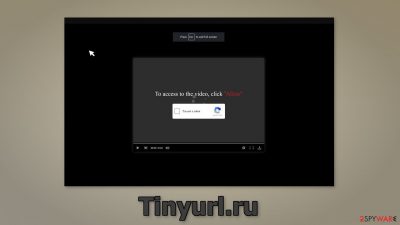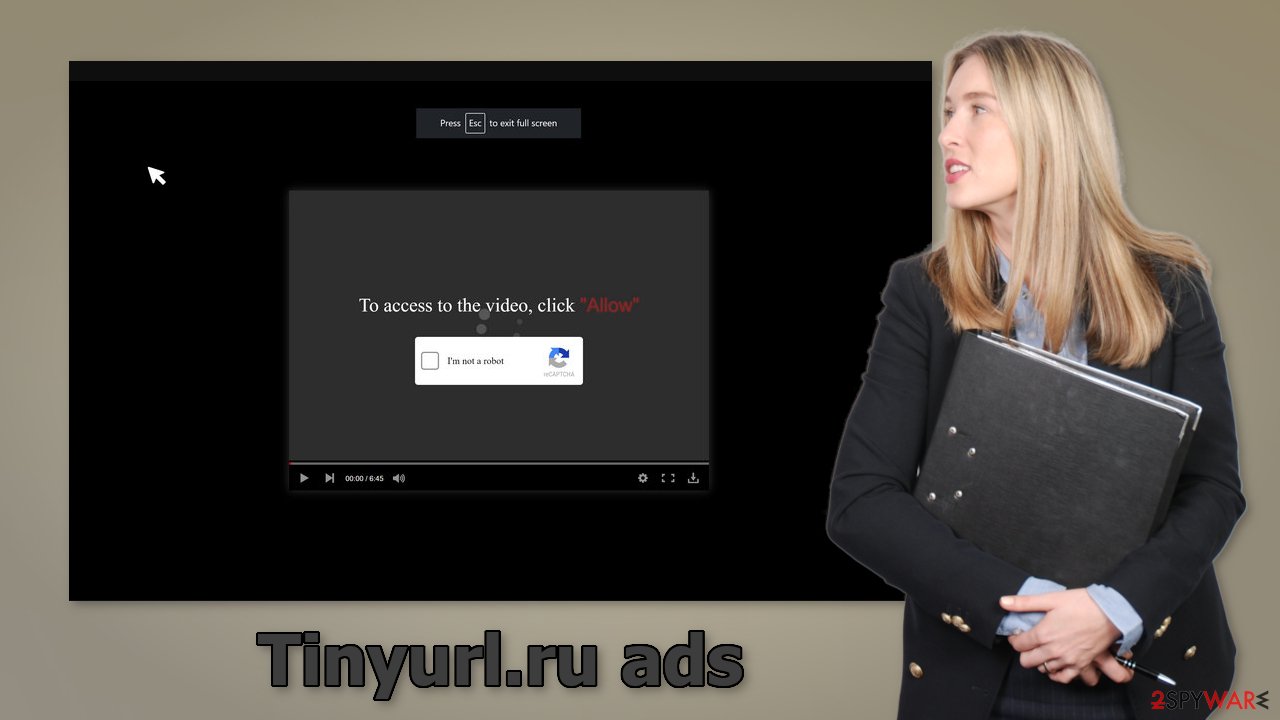Tinyurl.ru ads (fake) - Free Instructions
Tinyurl.ru ads Removal Guide
What is Tinyurl.ru ads?
Tinyurl.ru is used as a way to generate revenue with push notification spam

Tinyurl.ru is a bogus website that tricks people into allowing push notifications. It asks users to click the “Allow” button to be able to watch a video. In reality, there is no other content to explore besides the deceptive message and image. After an encounter with such a website, users start getting spammed with intrusive pop-up ads.
Push notification spam page creators rarely care about user privacy or security, so they use rogue advertising networks that place ads leading to dangerous websites. As a result, users can end up on pages that use social engineering methods[1] to make them provide personal information, download PUPs (potentially unwanted programs),[2] or even malware.
| NAME | Tinyurl.ru |
| TYPE | Push notification spam; adware |
| SYMPTOMS | Pop-up ads, banners appear on the screen even when the browser is closed |
| DISTRIBUTION | Shady websites; deceptive ads; freeware installations |
| DANGERS | Deceptive advertisements can lead to dangerous websites where users are at risk of giving away their personal information and suffering from monetary losses or downloading malicious software |
| ELIMINATION | Remove website permissions via browser settings or deploy professional security software to detect adware |
| FURTHER STEPS | Use FortectIntego for remediation and fix any damage left |
Tinyurl.ru overview
At first glance, Tinyurl.ru can remind people of a CAPTCHA verification process that asks users to confirm if they are not robots. However, a legitimate human verification should never ask you to choose between “Block” and “Allow” on a browser prompt.
Often, these pages also try to make it look like the user's browser is blocking access to content, however, that is also a lie. If you are asked to perform some type of action to see what is on the site, you should exit it immediately. Legitimate websites usually want to make themselves as user-friendly as possible, so asking users to click some buttons or follow links, is not something trustworthy businesses want to do.
You should also be aware, that these pages are rarely found through the search results. Usually, users get redirected to them through other shady pages. You should avoid sites that engage in illegal activities as they are full of deceptive ads and sneaky redirects that can take you to dangerous websites.

Cookies can pose a danger to your privacy
Cookies are simple text files that a website can store on your browser. The main purpose of a cookie is to identify users, save site login details or customize web pages according to the individual’s preferences. Most websites will install them to develop a profile for a person. Cookies will track each time a user visits a site, what they search for, what they buy, and more.
Unfortunately, not all websites can be trusted with data gathering. If you browse a lot, you most likely accepted the usage of cookies on many websites. You should consider deleting them on your browsers because they store your personal information.
These small text files can store data, like the sites you visit and the purchases you make. Websites can then track you and follow you to develop a more detailed profile. They can also slow down your device as over time, you accumulate a lot of them. The most worrying thing is that they can be hijacked. In the past, there have been instances where threat actors hijack cookies and gain access to browser sessions to steal personal data.
The good news is because they are stored on your device, they are quite easy to get rid of but can still take quite a lot of time if you use more than one browser. You can use FortectIntego optimization tool that can take care of this automatically. This software can also fix various system errors and fix corrupted files which is especially useful after a virus infection.
Stop pop-up ads from appearing
Push notifications work on a subscription-based model, so you will have to block them yourself. You can do this easily by following our step-by-step instructions:
Google Chrome (desktop):
- Open Google Chrome browser and go to Menu > Settings.
- Scroll down and click on Advanced.
- Locate the Privacy and security section and pick Site Settings > Notifications.
![Stop notifications on Chrome PC 1 Stop notifications on Chrome PC 1]()
- Look at the Allow section and look for a suspicious URL.
- Click the three vertical dots next to it and pick Block. This should remove unwanted notifications from Google Chrome.
![Stop notifications on Chrome PC 2 Stop notifications on Chrome PC 2]()
Google Chrome (Android):
- Open Google Chrome and tap on Settings (three vertical dots).
- Select Notifications.
- Scroll down to Sites section.
- Locate the unwanted URL and toggle the button to the left (Off setting).
![Stop notifications on Chrome Android Stop notifications on Chrome Android]()
Mozilla Firefox:
- Open Mozilla Firefox and go to Menu > Options.
- Click on Privacy & Security section.
- Under Permissions, you should be able to see Notifications. Click Settings button next to it.
![Stop notifications on Mozilla Firefox 1 Stop notifications on Mozilla Firefox 1]()
- In the Settings – Notification Permissions window, click on the drop-down menu by the URL in question.
- Select Block and then click on Save Changes. This should remove unwanted notifications from Mozilla Firefox.
![Stop notifications on Mozilla Firefox 2 Stop notifications on Mozilla Firefox 2]()
Safari:
- Click on Safari > Preferences…
- Go to Websites tab and, under General, select Notifications.
- Select the web address in question, click the drop-down menu and select Deny.
![Stop notifications on Safari Stop notifications on Safari]()
MS Edge:
- Open Microsoft Edge, and click the Settings and more button (three horizontal dots) at the top-right of the window.
- Select Settings and then go to Advanced.
- Under Website permissions, pick Manage permissions and select the URL in question.
- Toggle the switch to the left to turn notifications off on Microsoft Edge.
![Stop notifications on Edge 2 Stop notifications on Edge 2]()
MS Edge (Chromium):
- Open Microsoft Edge, and go to Settings.
- Select Site permissions.
- Go to Notifications on the right.
- Under Allow, you will find the unwanted entry.
- Click on More actions and select Block.
![Stop notifications on Edge Chromium Stop notifications on Edge Chromium]()
If the manual removal failed
If blocking the site permissions in your browser settings did not work, that might mean that you have a potentially unwanted program installed in your system that is generating ads in the background without your consent. Such programs are known as adware,[3] and usually, they sneak into the system from freeware distribution platforms.
They include additional programs in the installers to earn revenue, and most people do not notice the bundled software. You should always choose the “Custom” or “Advanced” installation methods, and read the Privacy Policy and Terms of Use. The most important part is to check the file list and untick the boxes next to any unrelated apps to prevent them from installing.
If you are unsure, that your system is completely safe and you still experience unwanted symptoms, you should use anti-malware tools like SpyHunter 5Combo Cleaner or Malwarebytes or other trusted ones and scan your system. Security software can also prevent such infections in the future by giving you a warning about suspicious programs.
If you want to try it yourself, follow the instructions for Windows and macOS:
Windows 10/8 machines:
- Enter Control Panel into Windows search box and hit Enter or click on the search result.
- Under Programs, select Uninstall a program.
![Uninstall from Windows 1 Uninstall from Windows 1]()
- From the list, find the entry of the suspicious program.
- Right-click on the application and select Uninstall.
- If User Account Control shows up, click Yes.
- Wait till uninstallation process is complete and click OK.
![Uninstall from Windows 2 Uninstall from Windows 2]()
Windows 7/XP:
- Click on Windows Start > Control Panel located on the right pane (if you are Windows XP user, click on Add/Remove Programs).
- In Control Panel, select Programs > Uninstall a program.
![Uninstall from Windows 7/XP Uninstall from Windows 7/XP]()
- Pick the unwanted application by clicking on it once.
- At the top, click Uninstall/Change.
- In the confirmation prompt, pick Yes.
- Click OK once the removal process is finished.
macOS:
- From the menu bar, select Go > Applications.
- In the Applications folder, look for all related entries.
- Click on the app and drag it to Trash (or right-click and pick Move to Trash)
![Uninstall from Mac 1 Uninstall from Mac 1]()
To fully remove an unwanted app, you need to access Application Support, LaunchAgents, and LaunchDaemons folders and delete relevant files:
- Select Go > Go to Folder.
- Enter /Library/Application Support and click Go or press Enter.
- In the Application Support folder, look for any dubious entries and then delete them.
- Now enter /Library/LaunchAgents and /Library/LaunchDaemons folders the same way and terminate all the related .plist files.
![Uninstall from Mac 2 Uninstall from Mac 2]()
How to prevent from getting adware
Stream videos without limitations, no matter where you are
There are multiple parties that could find out almost anything about you by checking your online activity. While this is highly unlikely, advertisers and tech companies are constantly tracking you online. The first step to privacy should be a secure browser that focuses on tracker reduction to a minimum.
Even if you employ a secure browser, you will not be able to access websites that are restricted due to local government laws or other reasons. In other words, you may not be able to stream Disney+ or US-based Netflix in some countries. To bypass these restrictions, you can employ a powerful Private Internet Access VPN, which provides dedicated servers for torrenting and streaming, not slowing you down in the process.
Data backups are important – recover your lost files
Ransomware is one of the biggest threats to personal data. Once it is executed on a machine, it launches a sophisticated encryption algorithm that locks all your files, although it does not destroy them. The most common misconception is that anti-malware software can return files to their previous states. This is not true, however, and data remains locked after the malicious payload is deleted.
While regular data backups are the only secure method to recover your files after a ransomware attack, tools such as Data Recovery Pro can also be effective and restore at least some of your lost data.
- ^ Social Engineering. Imperva. Data Security.
- ^ Potentially unwanted program. Wikipedia. The Free Encyclopedia.
- ^ Adware. Malwarebytes. Cybersecurity Basics.













